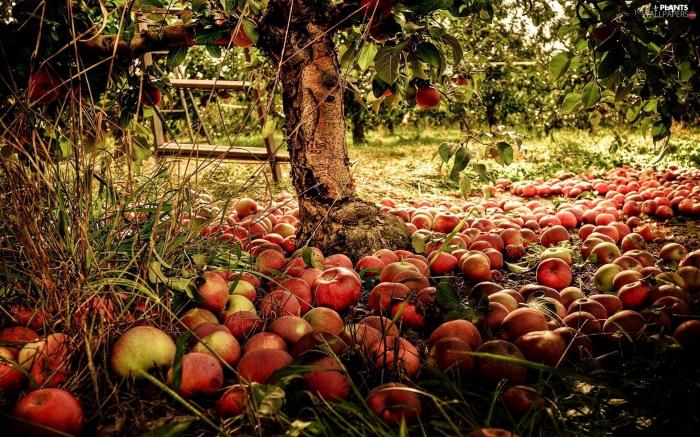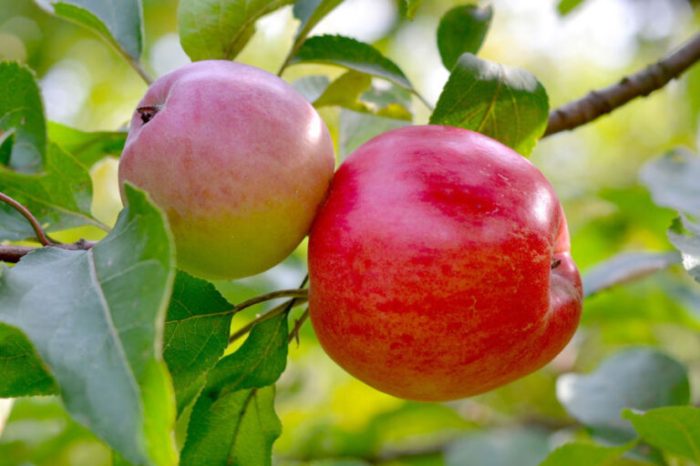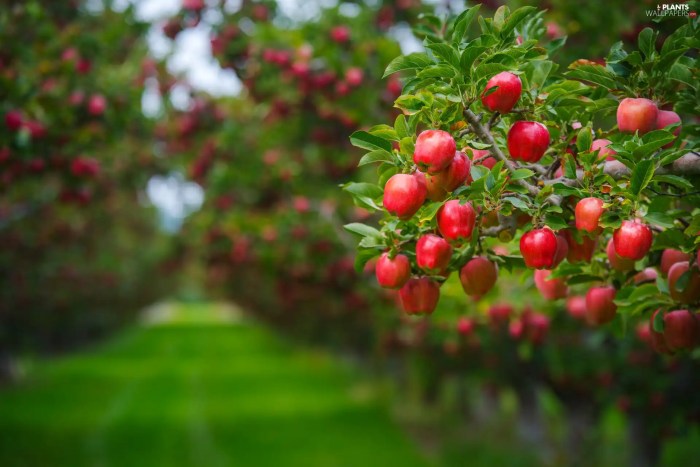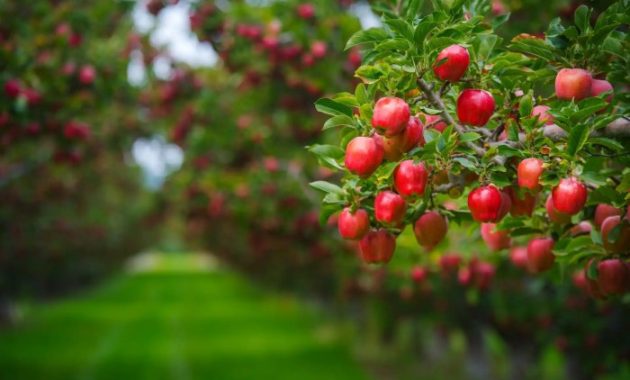Site Preparation and Soil Conditions

Plant apple trees in fall – Planting apple trees in the fall requires careful site preparation to ensure healthy growth and a bountiful harvest. The success of your apple trees hinges heavily on providing them with the ideal soil conditions and sufficient sunlight. Neglecting this crucial step can lead to stunted growth, poor fruit production, and even tree death.Proper soil drainage and sunlight exposure are paramount for the health and productivity of your apple trees.
Apple trees thrive in well-drained soil that prevents waterlogging, which can damage roots and make them susceptible to disease. They also require at least 6-8 hours of direct sunlight daily for optimal photosynthesis and fruit development. Choosing a location that meets these requirements is the first step towards a successful planting.
Soil Testing and Site Preparation
Before planting, it’s essential to test your soil to determine its pH level, nutrient content, and drainage capabilities. A soil test kit can be purchased from most garden centers or agricultural supply stores. These kits provide clear instructions for collecting and submitting a sample for analysis. The results will reveal any deficiencies or imbalances that need addressing before planting.
Once you have your soil test results, you can begin preparing the planting site. This involves removing any weeds, rocks, and debris from the area where the trees will be planted. If the soil is compacted, it may need to be loosened with a tiller or shovel to improve aeration and drainage. For example, a clay soil might require adding organic matter to improve its structure and drainage.
Soil Amendment Techniques
Based on your soil test results, you may need to amend the soil to improve its properties. Amendments are materials added to the soil to improve its physical, chemical, and biological characteristics. For instance, if your soil is too acidic (pH below 6.0), you can add lime to raise the pH. Conversely, if the soil is too alkaline (pH above 7.0), elemental sulfur can be added to lower the pH.
Autumn’s cool air is ideal for planting apple trees, ensuring strong root establishment before winter. This contrasts with the more involved process of growing catalpas from seed, detailed in this helpful guide: how to plant catalpa tree seeds. Understanding seed propagation techniques, however, can provide valuable insights applicable to other fruit trees, including those apple trees you’re preparing to plant this fall.
The amount of amendment needed will depend on the soil test results and the type of amendment used. Always follow the instructions on the product label carefully.
Incorporating Organic Matter
Adding organic matter to the soil is a highly beneficial practice that improves soil structure, water retention, and nutrient availability. Organic matter, such as compost, well-rotted manure, or leaf mold, enhances soil drainage, aeration, and microbial activity. Before planting, incorporate a generous amount of organic matter into the soil. This can be done by digging it into the planting hole or by tilling it into the surrounding area.
For example, adding a 3-4 inch layer of compost to the top 12 inches of soil significantly improves its quality and helps create a healthy environment for your apple tree roots. This organic matter will gradually decompose, providing nutrients and improving soil health over time. A well-amended soil will contribute to healthier, more vigorous apple trees, resulting in increased fruit production and disease resistance.
Long-Term Care and Maintenance: Plant Apple Trees In Fall

A healthy, productive apple tree requires consistent care throughout its lifespan. Regular maintenance, including pruning, fertilization, and pest control, will ensure a bountiful harvest for years to come. Neglecting these tasks can lead to reduced fruit production, disease susceptibility, and ultimately, the decline of your tree. This section details a schedule and techniques for long-term apple tree care.
Routine Maintenance Schedule
A yearly schedule is crucial for optimal apple tree health. Consistency is key, allowing you to address potential problems before they escalate. The timing of tasks can vary slightly depending on your specific climate and the variety of apple tree.
- Winter (Dormant Season): Pruning is best done during late winter or early spring before bud break. This allows the tree to heal before the growing season begins. Fertilizing can also be done during this period, providing nutrients for the upcoming season’s growth.
- Spring (Bud Break to Bloom): Monitor for pests and diseases. Apply preventative sprays if necessary, following label instructions carefully. Inspect for any winter damage and address accordingly.
- Summer (Fruit Development): Continue pest and disease monitoring. Thin fruit if necessary to promote larger, higher-quality apples. Water deeply during dry spells, especially for younger trees.
- Fall (Harvest to Leaf Drop): Harvest your apples. Clean up fallen leaves and fruit to reduce disease and pest overwintering sites. Mulch around the base of the tree to protect roots.
Proper Pruning Techniques
Pruning is essential for maintaining the shape and health of your apple tree, maximizing fruit production, and preventing disease. The goal is to create an open structure that allows sunlight to penetrate throughout the canopy.
- Removing dead, damaged, or diseased branches: These branches consume energy without contributing to the tree’s health. Cut them back to the branch collar (the slightly swollen area at the base of the branch).
- Thinning out crowded branches: This improves air circulation and sunlight penetration, reducing the risk of disease. Select branches to remove based on their position and vigor, prioritizing those that are crossing, rubbing, or growing inward.
- Heading back excessively long branches: This encourages branching and maintains a manageable tree size. Cut back to an outward-facing bud to promote growth in the desired direction.
- Maintaining a central leader (for most apple tree varieties): The central leader is the main vertical branch. Proper pruning maintains its dominance, providing a strong framework for the tree.
Preventing Common Apple Tree Diseases and Pest Infestations
Regular monitoring and preventative measures are crucial for protecting your apple trees from common diseases and pests.
- Disease Prevention: Proper sanitation, including removing fallen leaves and fruit, helps reduce disease spread. Choose disease-resistant apple varieties whenever possible. Ensure adequate air circulation through proper pruning. In cases of severe infection, consult a local arborist or agricultural extension office for advice on appropriate treatments.
- Pest Control: Regular inspection for pests such as aphids, codling moths, and spider mites is crucial. Early detection allows for timely intervention. Natural methods, such as introducing beneficial insects or using insecticidal soap, can be effective for minor infestations. For severe infestations, contact a local agricultural extension office or pest control professional for recommendations on appropriate treatments.
Illustrative Examples of Successful Fall Planting

Fall planting of apple trees, when done correctly, can yield remarkably strong and healthy trees. Proper site selection, soil preparation, and timely planting are crucial for success, leading to robust growth and bountiful harvests in the years to come. The following examples highlight both the potential rewards and the challenges you might encounter.
A Thriving Orchard Established Through Fall Planting
Imagine a picturesque orchard nestled on a gently sloping hillside, bathed in the warm hues of autumn. The soil, a rich loam with excellent drainage, is the result of careful amendment with compost prior to planting. Sunlight streams across the rows of apple trees, predominantly the ‘Honeycrisp’ variety, known for its exceptional flavor and crisp texture. These trees, planted the previous fall, stand tall and strong, their branches laden with vibrant, healthy foliage.
The consistent sunlight exposure, combined with the well-drained soil, prevents root rot and promotes strong root development. Careful pruning during the dormant season maintains the tree structure and encourages optimal fruit production. The trees exhibit vigorous growth, displaying a deep green color indicative of healthy chlorophyll production. This success story underscores the benefits of fall planting when the right conditions are met.
The consistent moisture levels during the fall and winter months, combined with the dormant period allowing for root establishment, sets the stage for robust growth in the spring.
Challenges Faced During Fall Planting and Mitigation Strategies, Plant apple trees in fall
A different orchard, planted in the same fall, faced a significant challenge: an unexpectedly early frost. The young trees, planted in a slightly lower-lying area with less sunlight exposure and heavier clay soil, experienced some frost damage to the newly forming buds. The clay soil, while fertile, retained too much moisture, making the trees more susceptible to frost damage.
The heavier soil also presented drainage challenges, increasing the risk of root rot. However, proactive measures were taken to mitigate the damage. The orchard owner applied a protective layer of mulch around the base of each tree to insulate the roots and prevent further frost damage. They also implemented a drip irrigation system to provide controlled watering, ensuring the trees received adequate moisture without over-saturating the soil.
Furthermore, the orchard owner carefully monitored the weather forecast and took preventative steps by covering the trees with frost cloth during particularly cold nights. While some minor damage occurred, the majority of the trees survived and eventually recovered, demonstrating that even with challenges, fall planting can still be successful with careful planning and diligent care.
Question & Answer Hub
Can I plant apple trees in the fall in all climates?
No, fall planting is best suited for regions with mild autumns and winters. In areas with harsh, early frosts, spring planting is generally recommended.
How deep should I plant my apple tree sapling?
The planting hole should be twice as wide as the root ball and just as deep. The graft union (the point where the scion is grafted onto the rootstock) should be above the soil line.
What kind of mulch is best for young apple trees?
Organic mulches like wood chips or shredded bark are ideal. They help retain moisture, suppress weeds, and regulate soil temperature.
How often should I water newly planted apple trees?
Water deeply and regularly, especially during dry periods, aiming to keep the soil consistently moist but not waterlogged.
What are common apple tree diseases I should watch out for?
Common diseases include apple scab, powdery mildew, and fire blight. Regular inspection and preventative measures are crucial.

